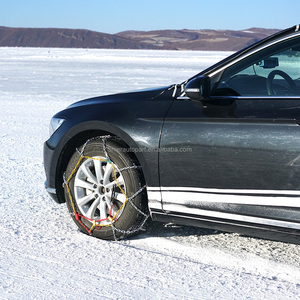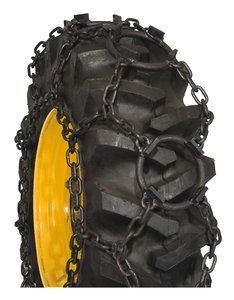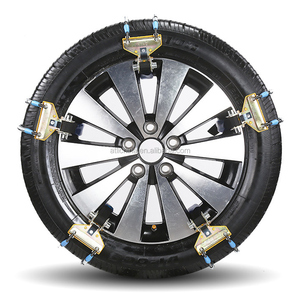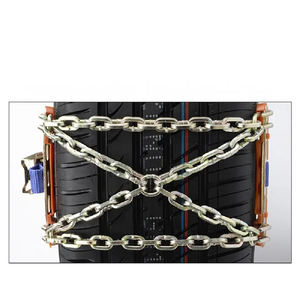(3933 products available)






































































































































































































Snow chain tyres, also called snow chains, are used on vehicles to provide better traction when driving through snow and ice. They are fitted onto the outside of a vehicle's tyres. Snow chains come in various types, such as:
When choosing snow chains, it is crucial to consider the expected road conditions, the type of vehicle, and the chain's compatibility with the tyre size.
Specification of snow chain tyres is important for both safety and performance reasons. Snow chains are designed to fit specific tire sizes and have varying link patterns and materials that affect their performance.
Tire size
The chains must be the same size as the tire to ensure a proper fit. The tire size can be found on the sidewall and is listed in width aspect ratio-diameter format. Example: 205/55 R16. The first number is the width of the tire in mm. The second number is the aspect ratio, which is the height of the tire sidewall in mm. The third number is the diameter of the wheel in inches. For example, 205/55-R16 means the tire is 205 mm wide, with a 55% aspect ratio and 16-inch diameter. Snow chains are required in some areas. They improve traction on ice and deep snow. Installing chains properly is important for safety and to avoid damage to vehicles and roads. When installing chains, check the manual for instructions specific to the vehicle. Incorrect installation can cause problems while driving.
Link pattern
Chains with diamond or square links provide better traction. The chain material affects the performance and durability of the chains. Steel chains last longer than other materials. However, they are heavier and can damage tires if not used correctly.
Inspecting snow chain tyres before and after use is important to ensure safety and performance. Look for broken chains, worn links, and rust. Worn links can reduce traction. Rust can weaken the chains over time. Proper cleaning after use in salt or slush areas is important. Rinse with water to remove salt and debris. Allow chains to dry completely to prevent rust. Proper storage keeps chains in good condition for the next use. Store in a dry, cool place away from sunlight. Protect chains and tires by removing chains when no longer needed in winter. Continued use on dry pavement can damage tires and chains. Regularly checking the owner's manual for the vehicle's chain installation and use instructions is important. This ensures safety and proper use, as different vehicles may have specific requirements for chain installation and use.
Wholesale buyers can get snow chains for sale, but before they place their orders, they need to consider the following factors:
Vehicle type and usage
Buyers should consider the type of vehicles the chains will be used on and the roads and terrains they often drive on. For instance, a heavy-duty truck operating in rural areas needs more durable chains than a passenger car used in urban settings.
Size selection
It's essential to get chains that are the right size for the tires. Incorrectly sized chains can cause damage or inadequate performance. Buyers can find the tire size on the sidewall of the tires or the vehicle's manual.
Type of snow chain tires
There are different types of snow chains, and each is suited for a specific purpose. For example, the ladder-type chains offer good general performance and are affordable. However, the V-bar chains are more expensive and offer excellent traction in icy conditions. Buyers should choose a type that fits their budget and needs.
Material construction
Snow chain tires are mainly constructed using steel. The chains made from carbon steel are more durable and resist corrosion, making them suitable for harsh winter conditions. Those made from nickel-plated steel are more affordable and suitable for occasional winter use.
Ease of installation
Buyers should consider how easy the chains are to install and remove. Some models require special tools, while others have manual installations or even self-tightening options. First, wholesalers should evaluate the installation time and decide whether the installation requires a professional or can be done at home.
Legal requirements
In some regions, especially areas with heavy snowfall, there might be legal requirements for using chains under specific conditions. Wholesalers should familiarize themselves with such regulations and ensure the chains meet the necessary standards.
Here is a step-by-step guide on how to install snow chains for tires:
Choose a safe location
The first step is choosing a safe location away from traffic. This allows drivers to install chains without distractions or hazards.
Lay out the chains
Once the location has been selected, the snow chain tires are laid out on the ground. This allows drivers to inspect them for any twists or tangles.
Drive into position
The vehicle is then moved so that the tires with the chains are on the side with less traffic. This ensures the driver can install the chains without worrying about passing vehicles.
Position the chain
The chain is positioned over the tire. The rubber tensioners are then placed over the top and bottom of the tire. This helps keep the chain in place during driving.
Secure the chains
Once the chains have been positioned, the tensioners are pulled tight. This ensures the chain fits snugly against the tire. The links on both sides of the tire are also secured. This prevents the chain from slipping off while driving.
Check the fit
After the chains are secured, the driver checks the fit. This is done by driving a short distance and then stopping to inspect the chains. If necessary, the tensioners are adjusted to ensure a proper fit.
Q1: Can snow chain tyres be used on dry pavements?
A1: Snow chains are not recommended for use on dry pavements. Using them on dry pavements can cause rapid wear of the chains and the tires and potentially damage the road surface due to increased traction effects.
Q2: How fast can one drive with snow chain tyres?
A2: When fitted with a snow chain, the speed limit is generally between 30 to 50 km/h. This is because higher speeds can cause damage to the chains, the tires, and the vehicle, as well as pose safety risks due to reduced traction.
Q3: How do you know if the snow chain is properly fitted?
A3: A properly fitted snow chain should be evenly distributed around the tire, with no slack or excessive tension. There should be no contact noise when driving, and the performance test can be done in a safe place to ensure good traction and stability.
Q4: How long can a snow chain last?
A4: The lifespan of a snow chain can vary based on usage, maintenance, and quality, but generally, a snow chain can last 2 to 5 years. Regular inspection and proper storage when not in use can extend the life of the chain.
Q5: Can snow chains be reused?
A5: Snow chains can be reused as long as they are in good condition and meet the required safety standards. Before reusing, they should be checked for wear, damage, and corrosion, and any problems should be repaired or replaced as necessary.